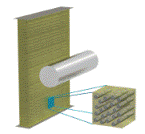Mechanical & Materials Engineering, Department of
Date of this Version
12-2010
Abstract
Nanotechnology and nanomaterials have the potential to revolutionize existing and create entirely new industries. Unique physical, mechanical, chemical, and biological properties of nanomaterials have been extensively documented in the last two decades. However, most nanomaterials are discontinuous in nature, creating problems with their processing and manipulation into devices and raising health concerns. Continuous nanofibers represent an emerging class of nanomaterials with critical advantages to applications. Continuous nanofibers are readily produced by electrospinning process comprising spinning polymer solutions in high electric fields. Electrospinning is a very economic top-down nanomanufacturing process that has been used to produce ultrafine continuous nanofibers from several hundred polymers, ceramics, carbon, and metals. The process allows integrated electromechanical nanofiber alignment and assembly into macroscopic 2D and 3D nanostructures. One issue with the classical single-jet electrospinning is its low production rate insufficient for most industrial applications. The objective of this research was to design, develop, study, and optimize a novel hybrid nanomanufacturing process for high-rate production of quality polymer nanofibers. The process combined centrifugal mechanical and electrical forces in an integrated single-step fashion. Initial design, development, and testing of the hybrid process were conducted. Comprehensive systematic parametric studies were performed on two important polymers, i.e. polyethylene oxide and polyacrylonitrile. Optimal parameters were determined for attaining the highest nanofiber production rate while maintaining high quality of the nanofibers. Nanofiber deposition density was studied and methods for obtaining a consistent deposition were determined. Exploratory analysis of several advanced process configurations, including configurations resulting in aligned nanofibers, wound nanofiber yarns, and nanofiber deposits on non-electroded surfaces was performed. The results demonstrated the feasibility of hybrid nanomanufacturing of high quality nanofibers with significant increases in nanofiber production rates, in comparison with the single-jet electrospinning. Integrated high-rate nanomanufacturing of aligned nanofiber sheets, wound yarns, and nanofilamentary deposits on non-electroded surfaces were also successfully demonstrated for the first time. The obtained results can be used to manufacture nanofibers for a broad range of applications spanning structural materials, composites, and energy, environmental, and biomedical applications.


Comments
A Thesis Presented to the Faculty of The Graduate College at the University of Nebraska in Partial Fulfillment of Requirements for the Degree of Master of Science Major: Engineering Mechanics Under the Supervision of Professor Ruqiang Feng Lincoln, Nebraska December 2010 Copyright 2010 Chad Thomas Peterson